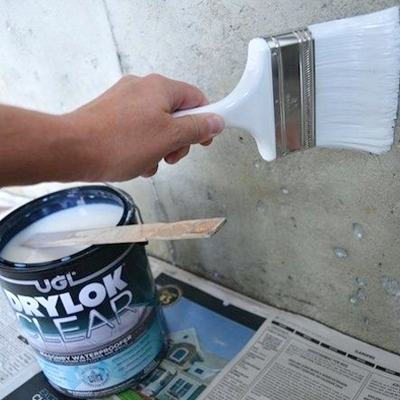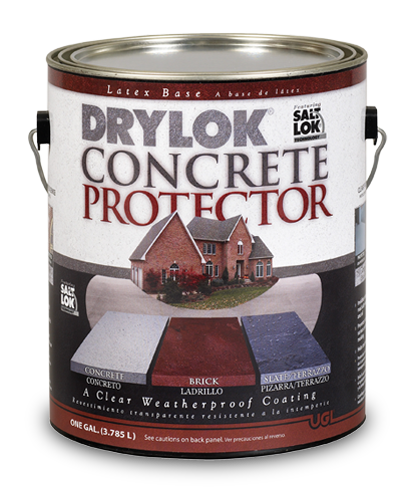If water is leaking through existing masonry or you need to protect new construction, our proprietary formula is GUARANTEED to stop water.
Unlike ordinary paint that simply adheres to a surface and can be forced off by incoming water pressure, DRYLOK® Clear Masonry Waterproofer actually penetrates the pores in that surface, bonding to the masonry and creating an impenetrable barrier.
Waterproof interior, exterior, above or below grade walls. DRYLOK® Clear Masonry Waterproofer is also perfect for floors, basements, retaining walls, decorative brick and stone facades, and more
Product Features:
DRYLOK® Clear Masonry Waterproofer may be applied on a slightly damp surface, but best results are obtained when the surface is dry, clean, and free of grease, oil, form release compound, and paint. Remove dust, dirt, and any loose or broken mortar with a wire brush*. Old paint in poor condition should be removed by wire-brushing, sandblasting or other suitable methods. If you see white, powdery, crystal-like deposits on the surface, they are naturally-occurring, water-soluble salt compounds in the masonry, pushed out by water intrusion. When the water evaporates, the salt residue remains. This effect is called efflorescence and, because it prevents DRYLOK® Clear Masonry Waterproofer from properly bonding to the surface, it must be removed. Treat it with DRYLOK® Etch®** (liquid or powder formula) or muriatic acid according to the manufacturer's directions. Proceed to rinse and allow the surface to dry. Since efflorescence occurs naturally, we cannot warrant against it reoccurring.
Patch all cracks and holes with DRYLOK® Fast Plug®. Wet the surface to be patched and, so DRYLOK® can better anchor itself into the wall, back chisel the areas to be patched into shapes like an inverted “V”. Apply and smooth the patch so it's even with the surface around it. As DRYLOK® Fast Plug® sets rapidly, mix only what you'll use in 3 to 5 minutes. Also, be sure to seal the area where the floor and wall meet. Often, when concrete floors cure, they shrink and pull away from the wall, creating a space where water can enter.
Floor Preparation
Highly troweled or extremely smooth concrete floors must be acid etched or mechanically abraded to achieve the proper profile. Treat the surface with DRYLOK® Etch®** (liquid or powdered) or muriatic acid, according to the manufacturer’s directions. A properly prepared concrete floor should look and feel like medium grit sandpaper. Repeat the etching procedure until the proper texture is achieved.
Test the concrete’s porosity and check for residual sealers by sprinkling a few drops of water on surface. If the water does not readily penetrate into the prepared concrete, additional acid etching is required. Remove any residual acid etching material from the surface, rinse it thoroughly and allow it to dry.
To check for trapped moisture, affix a 12” x 12” piece of 3 mil plastic or aluminum foil to the surface, taping it tightly along all four edges. Remove it after 24 hours. If the surface side of the plastic or foil is damp, allow additional drying and repeat the test.
Schedule your project when both air and surface temperatures are 50°F or higher and, for best results, wait for a dry (rain-free) period. Stir DRYLOK® thoroughly before and during application - do not thin. The product will appear milky in the can but it dries clear. Apply the first coat to bare masonry with a three-quarter-inch nap roller, DRYLOK® Brush or a quality nylon bristle brush. If using a brush, work DRYLOK® Clear Masonry Waterproofer into the pores of the masonry, making sure to fill all pores and pinholes, if using a roller, back brush the first coat to fill all pores and pinholes. Give the first coat 3 hours to dry, and then apply a second coat using a roller, brush or sprayer (download our Spray Specs).
For proper coverage, a minimum of 2 coats is required. After the second coat, carefully inspect the entire surface for pinholes. In areas where pinholes are still present, apply an additional coat of DRYLOK® Clear Masonry Waterproofer. If leaking is still present after two coats, it indicates that pores or pinholes are still open. Paint these areas again.
Floor Application
To achieve uniformity, apply 2 coats of product, making sure to apply the second coat in a cross direction to the first coat. The surface can be subjected to light foot traffic within 4 hours and heavy foot traffic within 24 hours. DRYLOK® Clear Masonry Waterproofer is not recommended for surfaces that are subject to vehicular traffic. If you plan to cover the surface with flooring or carpeting, allow the final coat of DRYLOK® Clear Masonry Waterproofer to dry for 24 hours. Only use water base adhesives when installing flooring. If topcoating, use a water-based paint or coating. Any screws, nails or anchors that penetrate the coating will nullify the waterproofing properties. Lift and place items on floor surfaces to avoid marring.
NOTE: Waterproofed surfaces may become slippery when wet. If slip-resistance is desired, add 2-4 ounces of DRYLOK® Non-Skid Texture Additive to each gallon.
Dispose of contaminated absorbent, container and unused contents in accordance with local, state and federal regulations.


Just like natural and man-made stone, concrete and masonry are porous materials. They will start to break down, dust, pit, crack, and/or stain easily when subjected to weather, water, oil, and UV rays. The only way to prevent damage and deterioration is to protect surfaces with a good quality sealer. Latex base DRYLOK® Concrete Protector provides clear, weatherproof protection against deterioration caused by de-icing salts, household cleaners, acid, gasoline, oil, and weathering. Formulated with our exclusive SALTLOK® Technology, it penetrates into the surface and provides superior resistance to unsightly efflorescence stains (salt deposits) that are often visible on brick, block, and poured concrete surfaces.
Protect interior, exterior, vertical, and horizontal masonry surfaces like stucco, brick and concrete. Prevents excessive dusting, surface cracking and pock marking.
Product Features:
How to use DRYLOK® Masonry Waterproofer to Protect Garden Statues, Flower Pots and other Masonry
See more Home Improvement Videos
Remove all dirt, wax, dust, mildew, and loose or scaling material with a scraper, wire brush or stiff bristle brush.* Grease, wax and oil should be removed by scrubbing with DRYLOK® Concrete Cleaner & Degreaser according to manufacturer’s directions or use a heavy duty detergent in warm water. Rinse the surface thoroughly with clean water and allow it to dry. Using a pressure washer? Do not use on a pressure setting above 1750 psi, to avoid damaging the concrete. Remember, concrete acts like a sponge. Pressure washing and general cleaning may trap residual moisture in the concrete.
To check for trapped moisture, affix a 12” x 12” piece of 3 mil plastic or aluminum foil to the surface, taping it tightly along all four edges. Remove it after 24 hours. If the surface side of the plastic or foil is damp, allow additional drying and repeat the test.
If you see white, powdery, crystal-like deposits on the surface, they are naturally-occurring, water-soluble salt compounds in the masonry, pushed out by water intrusion. When the water evaporates, the salt residue remains. This effect is called efflorescence and, because it prevents DRYLOK® Concrete Protector from properly bonding to the surface, it must be removed. Treat it with DRYLOK® Etch®** (liquid or powder formula) or muriatic acid according to the manufacturer's directions, rinse the surface and allow it to dry.
DRYLOK® Etch® will also properly prepare the concrete’s profile to accept the coating. Properly prepared concrete should look and feel like medium grit sandpaper. If the concrete remains smooth, repeat the etching procedure. You can test the concrete porosity by sprinkling a few drops of water onto the surface in several areas. If the water is readily absorbed, you are ready to apply the coating. If it beads or sits on the surface, additional cleaning and etching is needed. Rinse thoroughly with clean water and allow the surface to dry for 24 hours.
Patch all holes and cracks with DRYLOK® Concrete Patch or a suitable cement-based patching compound. Be sure to smooth the patch evenly. Allow the patched area to dry thoroughly.
Schedule your project when both air and surface temperatures are 50°F or higher and, for best results, wait for a dry (rain-free) period. Do not thin the product. DRYLOK® Concrete Protector appears milky in the can but dries clear. Apply by brush, roller, spray, or squeegee. Spread evenly and do not allow puddles or a heavy surface film to occur. Apply one coat using thin even strokes. Extremely porous surfaces may require a second coat. Allow 6 hours drying time between coats. Additional coats will cause the surface to become slippery when wet.
On light-colored surfaces, some darkening may occur. Test the product before use in an inconspicuous area to be sure darkening does not occur. DRYLOK® Concrete Protector may be applied to surfaces previously coated with a similar treatment. For best results, test a small area for proper adhesion prior to coating the entire surface.
DRYLOK® Concrete Protector may be applied over existing paints and coatings. In addition to normal surface preparation, old glossy surfaces must have the gloss removed by using sandpaper. Remove all sanding dust with a vacuum or tack cloth. Many previously coated surfaces may only require one coat.
Optional
Up to 2 ounces of DRYLOK® Non-Skid Texture Additive may be added to DRYLOK® Concrete Protector to improve traction.
Dispose of contaminated absorbent, container and unused contents in accordance with local, state and federal regulations.

